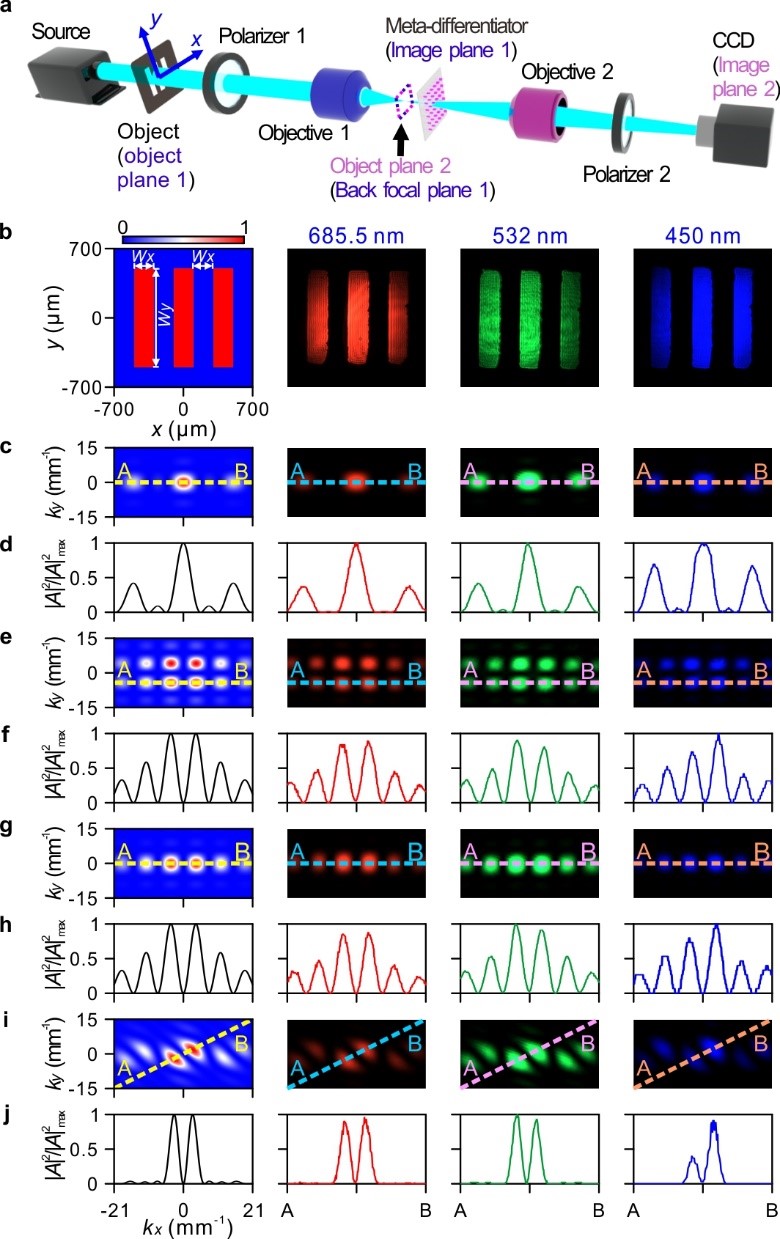Recently, Professor Jian Wang and Professor Lin Chen's team from Wuhan National Laboratory for Optoelectronics, Huazhong University of Science and Technology, together with Professor Andrea Alù's team from the City University of New York, have published a paper in Nature Communications titled Broadband angular spectrum differentiation using dielectric metasurfaces.
Signal processing is crucial for several science and engineering disciplines. Optical analog processing offers the advantage of performing massive parallel processing with high speed and low power consumption compared to digital signal processing based on integrated electric circuits. Spatial differentiation enables edge detection or extraction in an optical image, which is the first step in objection detection, feature classification. Optical imaging processing can be performed via a 4F system by placing processors on the confocal plane. However, this system is bulky and not well-suited for integrated devices. In contrast, metasurface can perform analog imaging processing as compact devices. Many works have been done to realize spatial differentiation based on metasurfaces.
This work focuses on the mathematical operations on the angular spectrum of an image and demonstrates “angular spectrum analog meta-processors”, which are different from spatial differentiation. These meta-processors can be used to perform optical analog processing of the Fourier spectrum - such as differentiation, integration, convolution, and other linear operations - as light propagates through them. This work realizes three types of angular spectrum differentiation based on dielectric metasurfaces composed of silicon nanopillars with the same cross-sections. These three types of angular spectrum differentiation are achieved by only changing the distributions of the orientation angles θ of the silicon nanopillars. The local orthogonal polarized transmission coefficient σ is proportional to sin(2θ), which satisfies the requirements of the three types of angular spectrum differentiation (Figure 1). This work experimentally demonstrates the angular spectrum differentiation of three parallel rectangular holes across the visible spectrum (Figure 2) and the application potential of isolating features in the angular spectrum domain of an object (Figure 3).

Figure 1. Angular spectrum meta-differentiator. (a-c) Angular spectrum analog meta-differentiators with their corresponding angular spectrum operation, Ĥ, being, respectively, ∝∂2/(∂kx∂ky) (a), ∝∂/∂kx (b), and ∝∂/∂kx+∂/∂ky (c). (d) Schematic of the rotated silicon nanopillar on a silica substrate (e, f) Amplitude (e) and phase (f) of σ versus orientation angle θ. (g-l) Schematics of the top view presenting the distribution of the orientation angles of the three meta-differentiators (j-l) with ∂2/(∂kx∂ky) (g, j), ∂/∂kx (h, k) and ∂/∂kx+∂/∂ky (i, l), respectively.

Figure 2. Measured angular spectrum differentiations of three parallel rectangular holes. (a) Experimental setup for performing angular spectrum operation of an object. (b) Theoretical (the first panel) and experimental (the second to fourth panels) intensity distributions of three parallel rectangular holes. (c, d) Angular spectrum intensity distributions (c) and normalized intensity profiles along lines A-B in (c) (d). (e-j) Angular spectrum intensity distributions with ∂2/(∂kx∂ky) (e), ∂/∂kx (g), and ∂/∂kx+∂/∂ky (i), and their normalized intensity profiles along lines A-B (f, h, j).

Figure 3. Angular spectrum isolation experiment. (a) Experimental setup for performing angular spectrum isolation. (b-e) Angular spectrum intensity distributions of the mixed light without (b) and with (c) the meta-differentiator with ∂/∂kx. Their normalized angular spectrum intensity profiles along the lines A-B are shown in (d) and (e), respectively.
Professor Lin Chen is supported by the National Key Research and Development Project of China, National Natural Science Foundation of China, and Science, Technology and Innovation Commission of Shenzhen Municipality. Michele Cotrufo and Andrea Alù are supported by the Air Force Office of Scientific Research and the Simons Foundation.
Link: https://www.nature.com/articles/s41467-024-46537-9